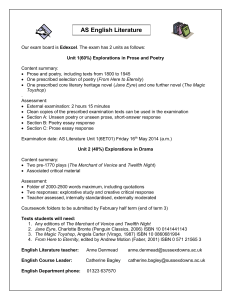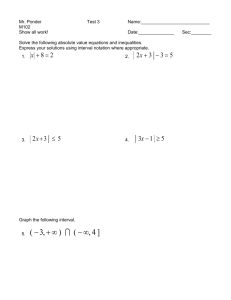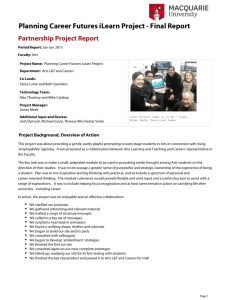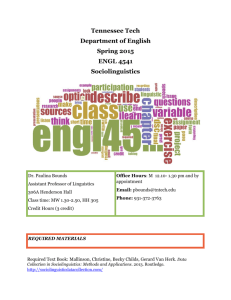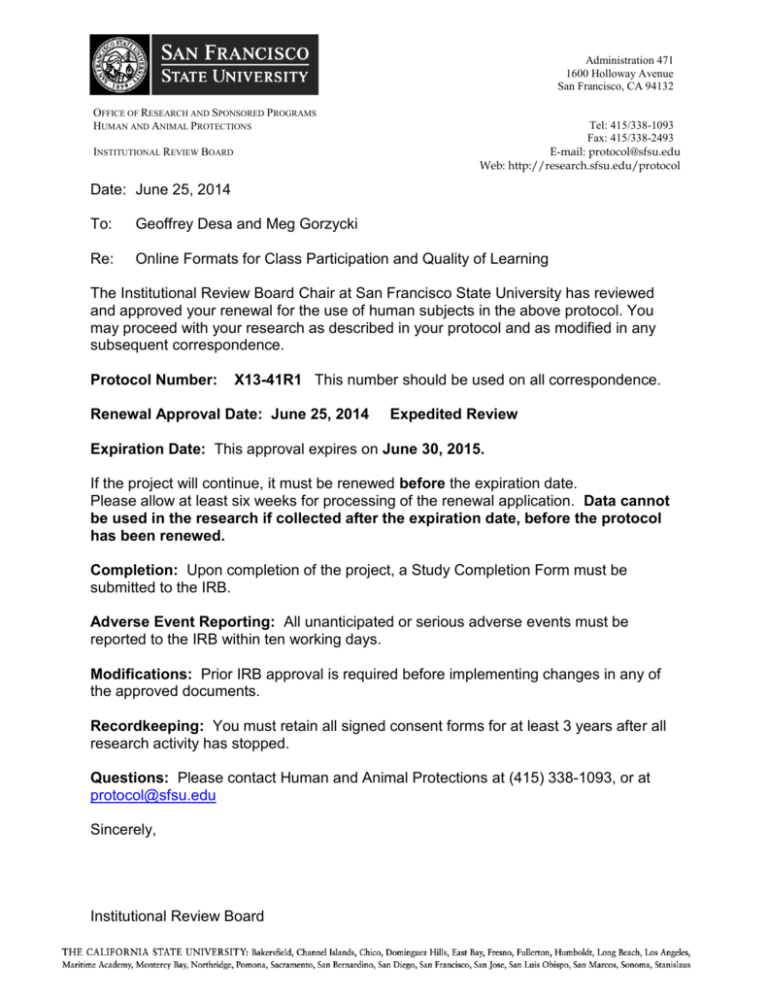
Administration 471
1600 Holloway Avenue
San Francisco, CA 94132
OFFICE OF RESEARCH AND SPONSORED PROGRAMS
HUMAN AND ANIMAL PROTECTIONS
INSTITUTIONAL REVIEW BOARD
Tel: 415/338-1093
Fax: 415/338-2493
E-mail: protocol@sfsu.edu
Web: http://research.sfsu.edu/protocol
Date: June 25, 2014
To:
Geoffrey Desa and Meg Gorzycki
Re:
Online Formats for Class Participation and Quality of Learning
The Institutional Review Board Chair at San Francisco State University has reviewed
and approved your renewal for the use of human subjects in the above protocol. You
may proceed with your research as described in your protocol and as modified in any
subsequent correspondence.
Protocol Number:
X13-41R1 This number should be used on all correspondence.
Renewal Approval Date: June 25, 2014
Expedited Review
Expiration Date: This approval expires on June 30, 2015.
If the project will continue, it must be renewed before the expiration date.
Please allow at least six weeks for processing of the renewal application. Data cannot
be used in the research if collected after the expiration date, before the protocol
has been renewed.
Completion: Upon completion of the project, a Study Completion Form must be
submitted to the IRB.
Adverse Event Reporting: All unanticipated or serious adverse events must be
reported to the IRB within ten working days.
Modifications: Prior IRB approval is required before implementing changes in any of
the approved documents.
Recordkeeping: You must retain all signed consent forms for at least 3 years after all
research activity has stopped.
Questions: Please contact Human and Animal Protections at (415) 338-1093, or at
protocol@sfsu.edu
Sincerely,
Institutional Review Board
Administration 471
1600 Holloway Avenue
San Francisco, CA 94132
OFFICE OF RESEARCH AND SPONSORED PROGRAMS
HUMAN AND ANIMAL PROTECTIONS
Tel: 415/338-1093
Fax: 415/338-2493
E-mail: protocol@sfsu.edu
Web: http://research.sfsu.edu/protocol
INSTITUTIONAL REVIEW BOARD
Date: July 5, 2013
To:
Geoffrey Desa and Meg Gorzycki
Re:
Online Formats for Class Participation and Duality of Learning
The Institutional Review Board Chair at San Francisco State University has reviewed
and approved the use of human subjects in the above protocol. You may proceed with
your research as described in your protocol and as modified in any subsequent
correspondence.
Protocol Number: X13-41
Approval Date:
July 5, 2013
Expedited
Expiration Date: This approval expires on July 4, 2014.
If the project is to be continued, it must be renewed by the expiration date. Please allow
at least six weeks for processing of a renewal application. Data cannot be used in the
research if collected after the expiration date, before the protocol has been
renewed.
Completion: Upon completion of the project, a Study Completion Form must be
submitted to the IRB.
Adverse Event Reporting: All unanticipated or serious adverse events must be
reported to the IRB within ten working days.
Modifications: Prior IRB approval is required before implementing any changes in any
of the approved documents. Data cannot be used if collected before any changes
in the research are approved.
Recordkeeping: You must retain all signed consent forms for at least 3 years after all
research activity is completed.
Questions: Please contact ORSP - Human and Animal Protections and the
Institutional Review Board at (415) 338-1093, or at protocol@sfsu.edu
Sincerely,
Institutional Review Board
San Francisco State University Online Formats for Class Participation and Quality of Learning Researchers: Geoff Desa, Ph. D. and Meg Gorzycki, Ed.D. Departments: Management and the Center for Teaching and Faculty Development I.
Study Aim, Background and Design a. The research questions are: i. How much time do students spend reading course materials on-­‐line? ii. How many times do students contribute to on-­‐line discussion during the course? iii. What is the quality of students’ contribution to on-­‐line discussions? iv. Do students find on-­‐line reading helpful to their success in the course? v. Do students find participation in on-­‐line discussion helpful to their success in the course? vi. What are the distinct benefits of iLearn discussion forum? vii. What are the distinct benefits of Ponder? viii. How does participation in i-­‐Learn discussion forum and Ponder activities impact student competency? ix. Are there any significant differences between the student achievement of those using Ponder and those using iLearn discussion forum? b. As college and universities are relying more upon on-­‐line instruction to fulfill the need to move students expeditiously through their undergraduate programs, and as technology is constantly providing new ways to deliver information, engage students, and assess student learning, it behooves the academic community to understand the benefits and limitations of various computer programs designed to facilitate learning. Among the chief concerns of higher education are literacy and the ability to students to read proficiently. Literacy and the capacity to read critically are vital to college success. Nist and Simpson (2000) found that approximately 85% of learning in higher education involves reading and place the textbook at the center of curriculum. Others have found that reading contributes significantly to cognitive growth (Dahaene, 2009Glaser 1984) and to the growth of content knowledge (Goody, 1977). College students are routinely assigned advanced academic material but they do not always comprehend the information, and many freshmen college students complete their first year with few reading skills (Lei, Bartlett, Gorney, Hercshbach 2010). This occurs in part because professors assume students have the reading skills necessary for success, and believe that even if they did not have the skills, hold that it is not possible to teach the skills in college (Sherfield, et. Al., 2005). Some research claims that less than 30% of students complete reading assignments prior to class sessions (Clump, et. Al. 2004) and others note that non-­‐compliance with reading assignments is due to the student’s poor 1 reading comprehension, lack of understanding the importance of reading, low self-­‐
confidence, and procrastination (Lei, Rhinehart, Howard, Cho, 2010). Student achievement and successful completion of course work is also influenced by their participation in collaborative projects and group discussion (Handelsman, et. al., 2005). Coursework, however, is increasingly delivered and facilitated in digital formats, which raises questions about the efficacy of collaboration and class discussion. At present, at least 33% of all college students have taken at least one online course and many more have taken courses that are blended, meaning that 30%-­‐79% of the course content and interactive activities were facilitated in online venues (Allen & Seaman, 2010). As online course work is often asynchronous and undertaken in an environment physically isolated from one’s classmates, researchers seek to understand how these conditions impact class participation and student achievement. Class participation is defined as contributing to discussion, initiating questions, class attendance, unsolicited responses, and exercising collaborative skills; and, it is believed that such participation is beneficial as it stimulates critical thinking, improves communication skills, and enriches the group’s understanding of the material (Rocca, 2010; Sadera, et. Al., 2002). These benefits are consistent with the Constructivist theory of development, which asserts that knowledge is the product of the individual’s interaction with the social environment and shaped in part by peers and institutions (Vygotsky, 1978). The question of how instructors ought to facilitate class discussion was a source of controversy prior to the availability of online courses, and continues to be a source of debate as online courses gain popularity. Essentially, three alternative modes of facilitation are recognized; one may be the “guide on the side,” the omnipresent sage, or the ghost who rarely injects anything into class discussion online (Mazzolini, 2003). Research indicates that many students participate more in online discussions than in-­‐class discussions (Arbaugh, 2000) and that students who participate in online courses are very satisfied with their experience and believe they learned a lot form the course (Swan, 2001). Research also claims that the most effective online class discussion is that in which students receive clear guidance on participation, specific questions that prompt responses, discussion involves personal experiences, and in which students receive abundant praise for their contributions (Dallimore, 2004). Further, effective online class discussions reflect meticulous course design that prompts students to high levels of thinking and are characterized by a clear sense of expectations and appropriate instructor intervention (Bullen, 1998; Dennen, 2005). Research also indicates that getting students to participate in online discussions remains a challenge. While many students spend numerous hours “in” their online courses, they do not even contribute to class discussion, which frequently has an impact on their course grades (Beaudoin, 2002). This study will illuminate the variables that contribute to participation in online discussion and characterize the quality of such discussion. The study 2 will also explore the relationship between participation in online discussion and the quality of student performance on assignments and exams. The data will have important implications for course design and instruction. c. This research is a qualitative and quantitative study of student participation in online discussion and class activities. The inquiry will use information as follows: i. The review of 70 students’ iLearn discussion forum use (aggregate data) ii. The review of students’ Ponder use (aggregate data) iii. The evaluation of students’ performance on quizzes, exams, and one analysis of a scholarly article/case study (aggregate data) iv. Aggregate data from student surveys d. Researchers anticipate that the data gathered in this project will reveal insights about what motivates students participation in online discussion, whether participation in online discussion contributed to student achievement, students’ perception of class participation, and student’s needs relative to course design and instruction e. Researchers are not using deception in this study II.
Participant Population a. The participants are undergraduate students enrolled and previously enrolled in BUS 690 i. There will be approximately 130 current students in this study ii. All participants will be over age 18. iii. The participants are not members of a vulnerable population iv. The participants are already known by researchers as these individuals are current and former students of the Principal Investigator b. In order to be included in the survey, participants must be enrolled in BUS 690. The principal investigator will de-­‐identify personal information from previously enrolled students with a unique encrypted code. The encryption key to personally identifiable data shall be known only to the principal investigator who will retain the key in a locked desk in a locked office. The instructor will contact previously enrolled students via their sfsu e-­‐mail to invite them to participate in the research. The student must sign and return the consent form to the principal investigator before the subject’s quizzes, test score and assignments can be used. c. The students are not recruited, but are automatically part of the study population as the instructor will collect data on student work normally and routinely assigned in the course. This includes the regular assignment to participate in either the iLearn component of the course or its alternative, the Ponder component. Individual student test scores, quiz and assignment data will only be used if the student opts-­‐in to this research on the consent form. d. The invitation to participate in either iLearn or Ponder is found in Appendix E and the consent form to grant permission for research is found in Appendix F. e. The primary investigator already has access to the potential participants as they are current and former students. 3 III.
Study Procedures a. The study will take place over the course of six months. The primary investigator will gather data on students’ use of iLearn and Ponder, essentially tracking the number of times students participate in activities and assessing the quality of commentary offered in online discussion (See Appendices A and D). The primary investigator will examine de-­‐identified factual Ponder data from previous classes to document the frequency of student use and type of commentary offered in the Ponder discussion. The primary investigator will also gather data from quizzes and exams (as outlined in rubrics found in Appendix B), and an analysis exercise based on a scholarly journal (as described in the rubric found in Appendix C). The student survey is found in Appendix G. b. The following steps represent the chronology of activity in this study: i. The primary investigator will teach four sections of BUS 690 and will see that two sections are assigned the use of iLearn and two sections are assigned the use of Ponder. Ponder allows students to read online materials, flag readings they find interesting, and select single-­‐word responses from a bank of single-­‐word responses to convey their response to the reading to others enrolled in Ponder. Ponder also allows the instructor to track the minutes each reader spends on an article and how many articles a student reads. The iLearn format allows students to read materials online and the iLearn forum allows students to originate inquiries and contribute to class discussion. There are two major differences between Ponder and iLearn: 1) iLearn supports greater density of class discussion than does Ponder; and, 2) ILearn does not allow the instructor to track the number of articles students read or how much time is spent reading each article. These differences enable the researcher to detect whether one type of online forum is superior to the other as detected in student achievement with exams and critical reading exercises. The points awarded for participation in the iLearn and Ponder forums are equal. There are no restrictions to peer consultation, study groups, and collaborative reading imposed on students in either the Ponder or iLearn group. ii. The primary investigator will explain that students are required to participate in these online formats and that they will earn class participation points may for doing so. iii. Participants will commence their course work and complete assignments, including those online and including the scholarly article analysis. iv. The participants will take course quizzes and tests. v. At the end of the semester, the principal investigator will distribute a consent form (Appendix F) to students that briefly describes the research and requests permission from students to use data generated by assignments, quizzes, exams and the survey. The principal investigator will review the precautions that will be taken to preserve the students’ privacy. Students will have the option of granting/declining permission to use their data in research. Students will not be automatically entered into this research. Only data from students who have granted permission will be used in this research. 4 vi. The researcher will administer a student survey after the researcher has explained the purpose of the survey and offered participants the choice not to complete the survey. c. Research details: i. The research will take place on San Francisco State University’s campus. ii. The research is distributed over the course of one semester. iii. The research occurs during the normal course of the class iv. The total time commitment to complete the survey, which is the only item of research that is not a course requirement, is about 10-­‐15 minutes v. If participants miss class, they will have the same opportunities to complete work as would students under normal conditions vi. If students do not want to take the survey, they will leave the classroom as the survey will be administered at the end of the last class session d. The data gathered by reviewing student participation in online activities will answer the questions of how much time students spend in online discussions, what kind of quality is represent in student contributions to discussion, and what types of materials students read online. The data from quizzes and tests will represent student comprehension from the scholarly article analysis assignment, and the survey will help researchers understand what students thought was helpful about the online formats they used and how the course and instruction might be improved in general. The researchers will also be able to examine the patterns of participation and achievement found in the two groups that used the iLearn format and compare these patterns to those who used the Ponder format; thus, researchers may address the question of whether the online format is a significant factor in student achievement. e. The rubrics that will be used to assess student proficiency in tests, case study analysis, and online participation are based on criteria extrapolated from Bloom’s taxonomy (Krathwohl, et. Al., 1956). The criteria target various levels of performance with respect to the cognitive skills required for different tasks. The tasks are distinguished by the complexity and sophistication of cognition involved and students will be rated according to their proficiency with each discrete task, as noted in Appendices A-­‐D. IV.
Research Risks a. There is a minimal risk of a loss of privacy. As this investigation reflects the desire to better understand how regular courses and instruction may be improved, it necessarily uses data from real students whose names will be known to the instructor. The instructor will minimize the risk of loss of privacy by ensuring that data retrieved from Ponder, iLearn, test scores, quiz scores, the analysis assignment, and the survey are kept in a locked file in a locked office. The research will also indicate that participants should not identify themselves should they choose to complete the survey (See Appendix G). All digital data and encrypted data will be stored in a locked, pass-­‐word protected computer in a locked office. b. There are no physical risks in this research. c. There is a minimal risk that privacy be compromised; this risk will be reduced significantly as the primary investigator will file records of the interviews in a locked file in a locked office. 5 d. There are no focus groups or committee interviews associated with this research. e. There are no excessive risks in this study. f. The students involved in this study are all adults. These students would be required to take quizzes, take tests, complete the analysis assignment, and complete online assignments under normal circumstances, even if the instructor was not conducting a study on the instructional exercises that are most effective. The only data in this study that is unique and distinct from the normal course and instruction is the survey, and students will be reminded that the survey is optional, and by declining to complete it has no effect on their grades. g. This research does not involve employees at the workplace. h. This research does not employ deception per se, but it is not entirely transparent. As with classes of BUS 690 taught in the recent past, the instructor will gather data on student performances on tests, quizzes, assignments, and online activity; the students will not know, however, that this data will be the subject of scholarly research. This precaution is being taken to avoid the possibility that students will change their normal behavior (as in the Hawthorne Effect) to produce what they think the researcher seeks. V.
Confidentiality a. The data will contain the names of the students and there will be no coding system. Confidentiality will be maintained via normal procedures whereby professors keep student records in locked files in locked offices. b. There is no excessive risk in this study. c. The data will be kept in a locked file in the Dean of Faculty Affair’s office for a minimum of three years. VI.
Benefits a. Participants will not receive any extraordinary benefits for completing the survey, and they will not receive any extraordinary benefits from completing normal course assignments b. Participants may receive the benefit of knowing that their surveys helped researchers identify the ways curriculum and instruction might be improved for future classes VII.
Payment a. There will be no payment for participating in this research. VIII.
Costs a. There are no fiscal costs to participants. The primary investigator will be conducting this research over the course of normal work conditions in the summer of 2013. IX.
Academic Credit a. The academic credit associated with this project is identical to the academic credit students would generate by completing the course work regularly assigned in this course. X.
Alternatives a. As the inquiry is to study normal student behavior in a normal business class there is no alternative to participation. 6 XI.
Consent a. As noted in Section II, participants are students enrolled or previously enrolled in BUS 690 i. At the end of the semester, students will be provided with a consent form and have the opt-­‐in option to allow the researcher to use data generated by quiz scores, test scores, online participation, and the analysis assignment for research. ii. The consent form (Appendix F) includes information about the research, its purpose, measures to protect privacy, a request for permission to use specific data, and the option to decline. iii. The consent form and accompanying student survey are contained in Appendices F and G. b. The student survey (Appendix G) will only be administered to students currently enrolled in BUS 690 and will remain anonymous. However, in order to know which students agree to allow their work to be used, their names can be recorded in the informed consent document (Appendix F) and later de-­‐identified. c. This research does not use medical charts or make inquiry into the medical condition of participants. XII.
Investigator’s Qualifications a. Geoff Desa, Ph. D. is an assistant professor of management in the College of Business. He is a member of the Sustainability Group within the College of Business and teaches business and society, strategic management, and social entrepreneurship. Geoff's research examines resource mobilization and venture development in the technology and social entrepreneurship sector. He earned his Ph.D. in business from the University of Washington in Seattle with emphases in technology entrepreneurship, strategic management, and public affairs. Prior to that, Geoff worked at Novera Optics and at Hewlett Packard as an optical engineer. He earned his M.S. in electrical engineering from Stanford University. He is on the board of the Common Data Project, a technology social venture engaged in information technology privacy. b. Meg Gorzycki, Ed. D. is a faculty consultant at the Center for Teaching and Faculty Development. She holds a doctorate in education with an emphasis on curriculum design and professional development. She has served on several WASC committees that investigated and reported findings related to instruction, curriculum development, and faculty supervision and mentoring. She has designed and administered mentoring programs. Her current research concerns professional development and on April 17, 2012, she renewed her NIH certification to conduct research on human populations. c. Students will not perform any analysis of data or research for this study. d. There are no research assistants involved in this study. XIII.
Funding a. There is no funding from the university or external foundations for this research. 7 XIV.
References Allen, I. E., & Seaman, J. (2010). Class differences. Online education in the United States. Babson Park, MA: Babson Survey Research Group. Arbaugh, J. B. (2000). Virtual classroom versus physical classroom: An exploratory study of class discussion patterns and student learning in an asynchronous Internet-­‐based MBA course. Journal of Management Education, 24(2), 213-­‐233. Beaudoin, M. (2002). Learning or lurking? Tracking the “invisible” online student. Internet and Higher Education, 5, 147-­‐155. Bullen, M. (2007). Participation and critical thinking in online university distance education. The Journal of Distance Education/Revue de l'Éducation à Distance, 13(2), 1-­‐32. Clump, M., Bauer, H., & Bradley, C. (2004). The extent to which psychology students read textbooks: A multiple class analysis of reading across the psychology curriculum. Journal of Instructional Psychology, 31(3), 227-­‐ 232. Dallimore, E. J., Hertenstein, J. H., & Platt, M. B. (2004). Classroom participation and discussion effectiveness: Student-­‐generated strategies. Communication Education, 53(1). Dehaene, S. (2009). Reading in the brain. The new science of how we read. New York, NY: Penguin Books Glasser, R. (1984). Education and thinking: The role of knowledge. American Psychologist, 39, 65-­‐198. Dennen, V. P. (2005). From message posting to learning dialogues: Factors affecting learner participation in asynchronous discussion. Distance Education, 26(1), 127-­‐148. Goody, J. (1977). The domestication of the savage mind. New York, NY: Cambridge University Press. Lei, S., Bartlett, K., Gorney, S., & Herschbach, T. (2010). Resistance to reading compliance among college students: Instructor’s perspectives. College Student Journal, 44, 219-­‐229. Handelsman, M. M., Briggs, W. L., Sullivan, N., & Towler, A. (2005). A measure of college student course engagement. The Journal of Educational Research, 98, 184-­‐191. Krathwohl, D. R., Bloom, B. B., & Maisa, B. B. (1956). Taxonomy of educational objectives. The classification of educational goals, handbook I: cognitive domain. New York, NY: David McKay company, Inc. Lei, S., Bartlett, K., Gorney, S., & Herschbach, T. (2010). Resistance to reading compliance among college students: Instructor’s perspectives. College Student Journal, 44, 219-­‐229. Lei, S. A., Rhinehart, P. J., Howard, H. A., & Cho, J. K. (2010). Strategies for Improving Reading Comprehension among College Students. Reading Improvement, 47(1), 30-­‐42. Mazzolini, M., & Maddison, S. (2003). Sage, guide, or ghost? The effect of instructor intervention on student participation in online discussion forums. Computers & Education, 40(3), 237-­‐253. 8 Nist, S. T. & Simpson, M. L. (2000). College studying. In M. L. Kamil, P. B. Mosenthal, P.D. Pearson, & R. Barr (Eds.), Handbook of reading research (Vol III). Mahwah, NJ: Lawrence Earlbaum Associates. Rocca, K. A. (2010). Student participation in college classroom: an extended multidisciplinary literature review. Communication Education, 59(2), 185-­‐213. Sadera, W. A., Robertson, J., song, L., & Midon, M. N. (2009). The role of community in online learning success. MERLOT Journal of Online Learning and Teaching, 5(2), 277-­‐284. Sherfield, R. M.. Moody, R. J., & Moody, P. G. (2005). Cornerstone: Building on your best. Upper Saddle River: NJ: Pearson/Prentice Hall. Swan, K. (2001). Virtual interaction: Design factors affecting student satisfaction and perceived learning in asynchronous online course. Distance Education, 22(2), 306-­‐329. Vygotsky, L. (1978). Mind in society. The development of higher psychological processes. Boston, MA: President and Fellows of Harvard. 9 Appendix A Ponder Inventory Student __________________________________ Section _____ Semester _____________ 1. Number of hours student spent on average per article __________ 2. Number of articles student read over course of semester _________ 3. Number of discrete topics (from set of Ponder topics designed by instructor) read in semester________ 4. Number of flags student posted in Ponder in semester __________ 5. Quality of information student provided on flags in general: a. ______ Interest immediately relevant to course work b. ______ Interest somewhat relevant to course work c. ______ Interest unrelated to coursework 6. Number of tags posted in Ponder in semester __________ 7. Quality of tags in general: a. _______ Accurately identified the concept of import in the reading with great consistency b. _______ Accurately identified the concept of import in the reading with modest success c. _______ Had significant difficulty accurately identified the concept of import in the reading 8. What was the time frame most used to complete online readings? ________________________ Was there anything special or unique about the way this student used Ponder? 10 Appendix B Rubric for Test Performance Student __________________________________ Section_____ Semester ________________ Name of Test or Quiz ________________________________________________ 1. Number of objective multiple choice questions on exam/quiz _____________ 2. Number of objective multiple choice questions answered correctly ____________ 3. Rubric for analyzing short answer questions on the Marvel Enterprises case study is as follows. The rater will score responses by placing a number in the spaces provided under columns 2-­‐6. The numbers represent the following: * 4= Highly proficient (masterful recall, thorough thinking, deep understanding) 3= Largely proficient (Good recall, abundant thinking, largely understanding) 2= Sufficiently proficient (Adequate recall, some thinking, marginal understanding) 1= Not proficient (Poor recall, little thinking, weak understanding) NA indicates that the question did not prompt a given task. Question Number and Level(s) of Bloom’s Taxonomy 1: A, B, D Recall of Explanation Application Analysis of Synthesis of key of key ideas of process ideas or knowledge information and/or applications principals Judging and generating thesis with evidence 2: B, C 3: D, E, F 4: C, F 5: A, B, D 6: D, E, F * The level of Bloom’s taxonomy is represented by letters and that the letters correspond with the following six levels of the taxonomy of educational objectives: A. Knowledge of specific facts and procedure B. Comprehension of knowledge C. Application of knowledge and skill D. Analysis of knowledge and information E. Synthesis of knowledge, information, and skill F. Evaluation and judgment with use of evidence 11 Appendix C Rubric for Article/Case Study Analysis Student __________________________________ Section _____ Semester ________________ The rubric for evaluating the student’s performance on the case study analysis assignment is as follows. Criteria (4) Highly proficient (3) Largely Proficient (2) Sufficiently (1) Not Proficient Proficient Understands key ideas of case Applies knowledge of business principals to analysis Identifies the significance of the case Identifies the implications of alternative actions Synthesizes knowledge from multiple sources Understands cause-­‐effect relationships Perceives perspectives of entities in case study Presents a clear assessment supported by evidence Uses proper lexicon and grammar Articulation is organized in a logical fashion 12 Appendix D I-­‐Learn Inventory Student __________________________________ Section _____ Semester _____________ 1.
2.
3.
4.
How many questions or comments did the subject originate? __________ How many responses to others’ comments did the subject post? __________ How many connections to the concepts did the subjects post? __________ Identify the number of times the subject exhibited the following discrete behaviors in his or her commentary: a. ______ Asked for something to be explained or clarified b. ______ Offered clarifying information or explanations c. ______ Offered some analysis of an idea or issue (such as comparing it to other things, pointing out implications, noting cause-­‐effect relationships) d. ______ Synthesized knowledge and information (combined ideas and facts from divergent sources to create a new idea or insight) e. ______ Offered an opinion without developing evidence f. ______ Offered an opinion with some development of evidence g. ______ Offered commentary on matters unrelated to the course h. ______ Praised a classmate for his or her ideas i. ______ Made a reference to something interesting and relevant to the course that he or she read or saw in the news or other media 5. How many hours did this subject spend on iLearn discussion forum over the semester? ______________ Was there anything special or unique about the way this student used iLearn? 13 Appendix E Introduction and Directions to Ponder and iLearn Ponder Introduction: Your overall contribution to this course, your daily active verbal participation in the class discussion of cases and coverage of reading materials will be evaluated and generate points that contribute to your overall grade for the course. In addition, you will have the opportunity to engage in Ponder – an online social learning tool that will help you see what business topics are being followed by your classmates. Ponder functions as a social reader – it allows you to read, discover and share relevant articles. Ponder has an app which sits within your internet browser. It works in Firefox and in Google chrome. In grading class participation, both the quantity and quality of your class contributions in Ponder and in class is reviewed. Class participation is obviously a function of preparation, skills, attitude, and a willingness to actively commit yourself in front of your instructor and colleagues. A classroom is a cost-­‐free environment for experimenting and learning to "play the game." Make use of it. Shyness is no excuse, just as it is not in a real business environment. Directions for using Ponder: Here’s how you install and use Ponder. 1. In iLearn, click on the Online Reading Participation link (https://ilearn.sfsu.edu/sp2013/mod/url/view.php?id=165138). Enter your student ID and reading code. Then click on the link to sign-­‐up for Ponder. 2. Ponder link https://spring13.Ponder.is/en/feed/ 3. Register: clicking on the link above will take you to the Ponder sign-­‐up page. You will get an email for registration confirmation. 4. Reading settings: After signing-­‐up, Ponder will show you the class reading list. You can select which sites to allow. 5. Ponder will also prompt you to install the reading app in your browser. 6. Browse: Try out some websites (e.g. NyTimes), click on business news and find an article you wish to share. Select some text in the article and (left) click on it. Clicking on the "P" will take you to the Flag box, which will ask you to indicate relevant class concepts and a sentiment about the article. Click submit. 7. Participation measurement: Your participation is measured in aggregate. As some combination of articles flagged, time spent reading, and concepts indicated. 8. When you go to a site that you have allowed, the P turns purple -­‐-­‐ and that's how you know your reading is being measured. (Note: How much you read in depth and breadth is measured on a per student basis. No one but you will know the specific articles you read, unless you choose to share the article with the class.) 9. How much do you need to read/post? Read/Post to get a sense of how current events relate to the class. Each person reads differently, based on their familiarity with the language and ideas expressed. You don’t have to read the most or the deepest. Just become intellectually engaged with the class and the reading stream on Ponder. 14 iLearn Forum
Introduction: Your overall contribution to this course, your daily active verbal participation in case discussion and coverage of reading materials will be evaluated and generate points that contribute to your overall grade for the course. In addition, you will have the opportunity to engage in an iLearn Forum – an online social learning tool that will help you see what business topics are being followed by your classmates. The ilearn Forum functions as a social reader – it allows you to share relevant articles that you read and discover on the web. In grading class participation, both the quantity and quality of your class contributions in the iLearn Forum and in class is reviewed. Class participation is obviously a function of preparation, skills, attitude, and a willingness to actively commit yourself in front of your instructor and colleagues. A classroom is a cost-­‐free environment for experimenting and learning to "play the game." Make use of it. Shyness is no excuse, just as it is not in a real business environment. Directions for using iLearn Forum: Here’s how you use the iLearn forum. 1. In iLearn, click on the Online Reading Participation link (https://ilearn.sfsu.edu/sp2013/mod/url/view.php?id=165138). Enter your student ID and reading code. Then click on the link to reach the iLearn Forum. 2. The iLearn forum page is composed of a discussion forum with a stream of articles that have been shared by the class. 3. Posting to the Forum: Please select a site from the Reading List (and only from this list). 4. If you find an interesting article you wish to share, here's how to do so. Subject: Enter the title of the article. Message (enter the following into the message box): Title: Enter the title of the article again Source: Enter the site name (e.g. NY Times) Excerpt (100 words or less): Copy and paste an article excerpt that you find relevant, and wish to share with the class. URL: copy/paste the entire URL link for this article. Connection to class concepts: Select specific class concepts that relate to this article. (The list of example class concepts is posted on iLearn). 5. Please search the forum before posting. If the article has already been posted, please follow-­‐
up using the ‘Discuss’ link, rather than starting a new post. 6. Participation measurement: Your participation is measured in aggregate. As some combination of articles posted, responded to, and concepts indicated. 7. How much do you need to read/post? Read/Post to get a sense of how current events relate to the class. Each person reads differently, based on their familiarity with the language and ideas expressed. You don’t have to read the most or the deepest. Just become intellectually engaged with the class and the reading stream on the iLearn Forum. 15 Appendix F San Francisco State University Informed Consent to Participate in Research Online Formats for Class Participation and Quality of Learning A. PURPOSE AND BACKGROUND The purpose of this research is to better understand how to engage students with effective online reading and improve the quality of learning. The research looks at the relationship between online participation and performance on class assessments (including assignments, quizzes and tests). The researcher, Prof. Geoff Desa, is an Assistant Professor of Management at San Francisco State University. You are being asked to participate in this study because you are/were a student in BUS 690. B. PROCEDURES If you agree to participate in this research, the following will occur: •
•
•
•
You will be asked to take a brief survey at the end of class, which should take approximately 10 minutes to complete. Your previously completed BUS 690 tests and assignments will be included in this research. Your BUS 690 online participation data will be included in this research. Your total time commitment will be 10 minutes. C. RISKS Your decision whether or not to participate in this research will have no influence on your semester grade.
There is a risk of loss of privacy. However, no names or identities will be used in any published reports of the research. Only the researcher (Prof. Desa) will have access to student identifying information in this data. D. CONFIDENTIALITY The research data will be kept in a secure location in the researcher’s office and only the researcher will have access to the data. All research data will be stored in an encrypted document on a password-­‐protected computer. At the conclusion of the study, all identifying information will be removed and the data will be kept in a locked cabinet or office. The data may be used in the future only for research purposes consistent with the original purpose of the research stated in this consent. CSU policy requires that the data will be stored for a minimum of 3 years. Data will be kept for 5 years after the last publication from this study after which time the data will be destroyed. E. DIRECT BENEFITS There will be no direct benefits to the participant. 16 F. COSTS There will be no cost to you for participating in this research. G. COMPENSATION There will be no compensation for participating in this research. H. ALTERNATIVES The alternative is not to participate in the research. I. QUESTIONS You have spoken with Prof. Desa about this study and have had your questions answered. If you have any further questions about the study, you may contact the researcher by email at gdesa@sfsu.edu or you may contact the department Chair, Prof. Bruce Paton at bpaton@sfsu.edu. Questions about your rights as a study participant, or comments or complaints about the study, may also be addressed to the Office for the Protection of Human Subjects at 415-­‐338-­‐1093 or protocol@sfsu.edu. J. CONSENT You have been given a copy of this consent form to keep. PARTICIPATION IN THIS RESEARCH IS VOLUNTARY. You are free to decline to participate in this research, or to withdraw your participation at any point, without penalty. Your decision whether or not to participate in this research will have no influence on your present or future status at San Francisco State University. Name _____________________________ Signature _____________________________ Date: _________ Research Participant Signature _____________________________ Date: _________ Researcher 17 Appendix G Student Survey of Online Participation Please do not put your name on this document. You may answer the questions you feel comfortable answering and you may stop at any time. The survey should take approximately 10 minutes to complete. Participants must be 18 years of age or older to complete this survey. ! I testify that I am 18 years of age or older _____ Yes ____ No ! Please circle the online participation format you used in BUS 690 Ponder iLearn forum ! Approximately how many hours/week did you spend reading online for BUS 690? _______________________________ For the 10 questions below, please circle the number that best represents your findings; 1=Strongly disagree 2=Mildly disagree 3=Neutral 4= Mildly agree 5= Strongly agree 1.
2.
3.
4.
5.
6.
7.
8.
9.
10.
I made a strong effort to participate online. 1 2 3 4 5 The online participation format was interesting to me. 1 2 3 4 5 I am more inclined to join a discussion online than in class. 1 2 3 4 5 I generally do well in courses even without completing all 1 2 3 4 5 reading assignments. The online information from my classmates helped me succeed 1 2 3 4 5 in this course. The online materials made me think deeply and analytically. 1 2 3 4 5 Classmates’ contributions online improved my understanding 1 2 3 4 5 of the material. There was a strong relationship between the online reading 1 2 3 4 5 and class activities. Online participation made me want to read more about topics 1 2 3 4 5 and ideas. I would strongly recommend that instructors use the online 1 2 3 4 5 participation format I used. ! What did you find beneficial or problematic about online participation? Please comment. 18

